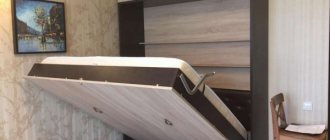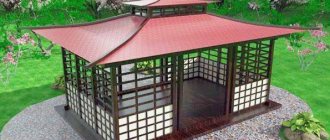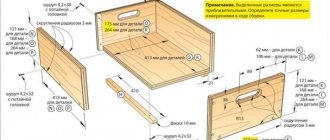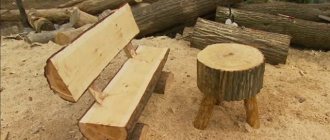DIY hammock stand
A hammock installed in the right place and in the right position guarantees a great rest. You can hang a hammock between two trees on a shady lawn, between rafters, on a porch—even in a bedroom, using straps, wall hooks, a hammock stand , or a combination of methods.
The best way is to make a hammock stand with your own hands , then you will not have problems with adjustment. At first glance, this may seem like a difficult task, but after reading the article, make sure that assembling such a structure is not a problem at all. If you have a drawing and step-by-step photographs, making a hammock stand is simple and inexpensive.
DIY stand made from a profile pipe
First you need to select tools and accessories:
- profile pipe with a square section of 40 by 40 mm. – 10 m;
- profile plugs – 6 pcs.;
- angle grinder (grinder) with cutting disc;
- welding machine;
- needle file;
- drill;
- hooks with threaded fastening—2 pcs.;
- spray paint.
Let's start making:
- It is necessary to cut the profile into fragments, the dimensions of which are reflected in the frame drawing (Figure 1).
- All fragments are connected by welding.
- The ends are processed with a needle file.
- The ends are “closed” with plastic plugs.
- In the racks on which the hammock is suspended, holes are drilled in the upper part. The hooks are secured in them with a thread-nut connection.
- The frame is painted with spray paint.
Master class on wicker furniture
How to weave a hammock?
A hammock chair is made using the macrame technique. With a little weaving experience, almost anyone can handle the job.
For the work process, you will need to prepare the following materials and tools:
- two metal hoops of different diameters 70 and 110 cm;
- 900 meters of cord;
- 12 meters of slings;
- two thick cords;
- 2 wooden rods;
- tape measure and scissors;
- work gloves.
Important: the cross-section of the selected hoops must be at least 3.5 cm. The cord for weaving must have a width of at least 4 mm. The process of making a hanging hammock chair is as follows:
The process of making a hanging hammock chair is as follows:
- A winding of hoops is created.
Here the main task is to completely cover the metal surface. The cord must be wound quickly and with good tension. To make the winding high-quality and dense, a tightening is done every twenty turns. It is better to work with gloves to prevent calluses from appearing on your hands. - Next we start weaving the mesh. Here you can use any macrame ornament. The simplest technique is considered to be chess. During operation, do not forget to constantly tension the cord. There is no need to rush to cut off the loose ends. At the end of the work process, they can be formed into a beautiful fringe.
- Now let's start assembling the hoop structure. They are tightly connected at one end with a cord.
- The next stage will be the formation of the back of the product. Weaving starts from the top and gradually moves down to the seat.
After braiding the pattern, the ends of the threads are fixed at the bottom, and a fringe is made from them. Now all that remains is to attach the slings and you can hang the chair indoors or outdoors.
Tip: to strengthen the structure, two strong cords are used connecting the seat and backrest.
Portable PVC Pipe Hammock Stand
The portability of the stand lies in its design. It consists of two separate PVC tubes with a cross-sectional diameter of 20 mm. and a profile length of 1800 mm.
They are buried in the ground, as shown in the photo, and then a hammock is suspended from the top of the pipes. To do this, you can attach threaded hooks to the pipe.
Important! You can do without hooks, but to do this, you need to make cuts to 1/3 of the pipe diameter on the outside of the pipes. These cuts accommodate the loops on the edges of the hammock.
A hammock with a canopy and frame has a large mass, but in the case of production from PVC pipes, special guy ropes are required for each pipe to hold the structure, as in the figure.
Recommendations
The process of weaving a hammock from thick rope or cord is quite easy, but requires some effort. To protect your hands from rough cords, you should wear gloves when making hanging interior items. This will allow you to tie the ropes carefully and keep the skin in order.
To finally understand the step-by-step patterns of weaving a rope hammock with your own hands, it is important to study the topic in depth. All canvases are created using the macrame technique
The more complex the product is in terms of weaving, the more beautiful and stronger it will be in the future.
All components and circuits should be worked out on small sections of cords
It is important to calculate the forces and choose the right material for creation. The hammock will turn out beautiful and strong if you pay attention to the process of weaving it.
Preliminary preparatory work
All parts are dried under the bright rays of the sun. If drying is very intense, water can be removed unevenly, which can generally cause fiber distortion. The workpiece should be stacked, installing special gaskets among the tiers to guarantee atmospheric circulation. And then the treatment is carried out using an antiseptic, which prevents the formation of a microorganism. Apply the mixture in a couple of layers and then dry again.
The workpieces are sanded using sandpaper, which is mounted on a grinder. To protect the structure from water, a varnish coating is needed.
To make wood fire resistant, a fire retardant is used.
Metal hammock stand
The use of metal in racks can be either continuous or spot. For example, the supports themselves can be made of wood, and the base and fastening points are additionally reinforced with metal plates, clamps, etc.
Wooden hammock stand with metal fasteners
The weakest element of any structure is always the attachment points and hinge joints. In order to strengthen a wooden rack, the seats for fasteners are “framed” with metal corners, profiles or sheets.
To do this, it is necessary to “dress” the tree in a metal profile, observing the mutual holes for bolted connections.
As a standard design, you can use the one shown in the figure.
Choosing a shape and material is the first step
Anyone can handle the manufacturing process. First, you should decide on the materials for fasteners and stock. If the hammock is wicker, then it is better to give preference to natural fabrics. Synthetic material is more difficult to work with and less durable.
There are some requirements for a hammock with a solid fabric. So, for example, when choosing canvas, you need to be prepared for difficulties in sewing.
Having chosen the type of hammock and material, you can begin further manufacturing work, and very soon the finished product will not only please the eye, but also contribute to an excellent rest.
From the drawing in the photo you can understand how to make a hammock with your own hands:
general information
The history of the appearance of the hammock in Europe is associated with the name of the famous discoverer Christopher Columbus. It was he who brought this exotic device from the Bahamas and showed it to the Europeans. Residents of the Bahamas used these wicker nets for sleeping, hanging such “cradles” between trees.
This use of hammocks appealed to the sailors, who during the voyage went to sleep in them instead of hard shelves and floors.
This is how sailors spent their nights on long journeys
Currently, hammocks can be found in the gardens of country houses and in comfortable apartments. The variety of these products allows you to choose the one that will meet all the requirements of a country resident or owner of city housing.
On a hammock you can:
- relax, relieve stress;
- sleep in the fresh air, and for a small child too;
- read books, have pleasant conversations with friends or family.
Even a small child can sleep in a hammock
Adults using a hammock for relaxation may unknowingly make some mistakes. You should not lie down in it, taking a position along the length of the entire structure. In this case, the hammock panel will not give you the opportunity to breathe freely and enjoy the beauty of the surrounding nature, since it will completely envelop you. The ideal position in a hammock is diagonal; in this position you can fully experience all the positive aspects of relaxing in a hammock.











